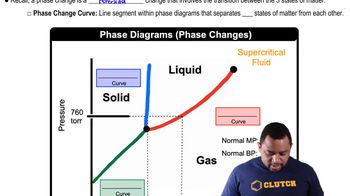(a) Which kind of intermolecular attractive force is shown in each case here? (b) Predict which of the four interactions is the weakest. [Section 11.2]
Ch.11 - Liquids and Intermolecular Forces
Chapter 11, Problem 5a
Using this graph of CS2 data, determine (a) the approximate vapor pressure of CS2 at 30°C,

Verified Solution
Video duration:
39sWas this helpful?
Key Concepts
Here are the essential concepts you must grasp in order to answer the question correctly.
Vapor Pressure
Vapor pressure is the pressure exerted by a vapor in equilibrium with its liquid or solid phase at a given temperature. It reflects the tendency of particles to escape from the liquid phase into the vapor phase. Higher temperatures generally increase vapor pressure, as more molecules have sufficient energy to overcome intermolecular forces.
Recommended video:
Guided course

Raoult's Law and Vapor Pressure
Phase Equilibrium
Phase equilibrium occurs when the rates of the forward and reverse processes of a phase change are equal, resulting in no net change in the amount of each phase. In the context of vapor pressure, this means that the number of molecules evaporating from the liquid equals the number condensing back into it, allowing for a stable vapor pressure at a specific temperature.
Recommended video:
Guided course

Phase Changes in Diagrams
Temperature Dependence of Vapor Pressure
The vapor pressure of a substance is highly dependent on temperature, typically increasing as temperature rises. This relationship is often described by the Clausius-Clapeyron equation, which relates the change in vapor pressure with temperature to the enthalpy of vaporization. Understanding this concept is crucial for interpreting vapor pressure data at different temperatures.
Recommended video:
Guided course

Raoult's Law and Vapor Pressure
Related Practice
Textbook Question
569
views
1
comments
Textbook Question
If 42.0 kJ of heat is added to a 32.0-g sample of liquid meth-ane under 1 atm of pressure at a temperature of -170°C, what are the final state and temperature of the methane once the system equilibrates? Assume no heat is lost to the surroundings. The normal boiling point of methane is -161.5 °C. The specific heats of liquid and gaseous methane are 3.48 and 2.22 J/g-K, respectively. [Section 11.3]
812
views
Textbook Question
The molecules
have the same molecular formula (C3H8O) but different chemical structures. (b) Which molecule do you expect to have a larger dipole moment? [Sections 11.2 and 11.5]
1268
views
Textbook Question
The phase diagram of a hypothetical substance is
(b) What is the physical state of the substance under the following conditions? (i) T = 150 K, P = 0.2 atm; (ii) T = 100 K, P = 0.8 atm; (iii) T = 300K, P = 1.0atm. [Section 11.6]
975
views
Textbook Question
At three different temperatures, T1, T2, and T3, the molecules in a liquid crystal align in these ways:
(a) At which temperature or temperatures is the substance in a liquid crystalline state? At those temperatures, which type of liquid crystalline phase is depicted?
594
views
1
rank
